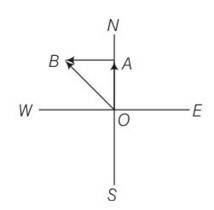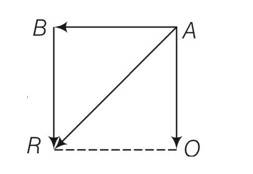Physics NCERT Exemplar Solutions Class 11th Chapter Five
Get insights from 67 questions on Physics NCERT Exemplar Solutions Class 11th Chapter Five, answered by students, alumni, and experts. You may also ask and answer any question you like about Physics NCERT Exemplar Solutions Class 11th Chapter Five
Follow Ask QuestionQuestions
Discussions
Active Users
Followers
New answer posted
4 months agoContributor-Level 10
This is a Multiple Choice Questions type Questions as classified in NCERT Exemplar
Answer- a
Explanation- x (t)= pt+qt2+rt3
V= dx/dt=p+2qt+3rt2
So a= o+2q+6rt
At t=2s a= 2q+6 2 (r)
= 2q+12r
= 2 (4)+12 (5)=68m/s
So F =ma= 2 (68)= 136N
New answer posted
4 months agoContributor-Level 10
This is a Multiple Choice Questions type Questions as classified in NCERT Exemplar
Answer- c
Explanation –consider the adjacent diagram

OA= p1= initial momentum of player northward
AB= p2= final momentum of player towards west
OB= OA+AB

Change in momentum = P2-P1= AB-OA so we can say that AR will be along south west.
New answer posted
4 months agoContributor-Level 10
This is a Multiple Choice Questions type Questions as classified in NCERT Exemplar
Answer- d
Explanation-we know that for a system Fext=dp/dt
If Fext=0, dp =0,
P = constant
Hence, momentum of a system will remain conserve if external force on the system is zero.
In case of collision between particles, equal and opposite forces will act on individual particles by newton's third law.
according to newton's 2nd law F=dp/dt
If F =0 then p = constant so momentum remains constant if external force is zero.
New answer posted
4 months agoContributor-Level 10
This is a Multiple Choice Questions type Questions as classified in NCERT Exemplar
Answer- c
Explanation- change in momentum =- [0.9? +1.2? ]
Magnitude =
1.5 kg m s-1
New answer posted
4 months agoContributor-Level 10
This is a Multiple Choice type Questions as classified in NCERT Exemplar
Answer- c
Explanation- given u= (3? +4? )m/s
And v= - (3? +4? )m/s, and mass of ball is 150g=0.15kg
Change in momentum = final momentum – initial momentum
= mv-mu
= m (v-u) = 0.15 [- (3? +4? )- (3? +4? )]
= - [0.15 ]
= - [0.9? +1.2? ]
P =- [0.9? +1.2? ]
New answer posted
4 months agoContributor-Level 10
This is a Multiple Choice type Questions as classified in NCERT Exemplar
Answer-b
Explanation- to solve this question we have to apply newton's law of motion, in terms of force and change in momentum.
as we know F= dp/dt
As body moving uniform velocity so dp= 0
So F=0
As all part of scale is moving with uniform velocity and total force is zero . hence torque will also be zero.
New answer posted
4 months agoContributor-Level 10
This is a Multiple Choice Type Questions as classified in NCERT Exemplar
Answer- c
Explanation- in a uniform translatory motion, all parts of the ball have the same velocity in magnitude and direction and this velocity is constant . in this situation body A will be in translatory motion.
Taking an Exam? Selecting a College?
Get authentic answers from experts, students and alumni that you won't find anywhere else
Sign Up on ShikshaOn Shiksha, get access to
- 65k Colleges
- 1.2k Exams
- 679k Reviews
- 1800k Answers
